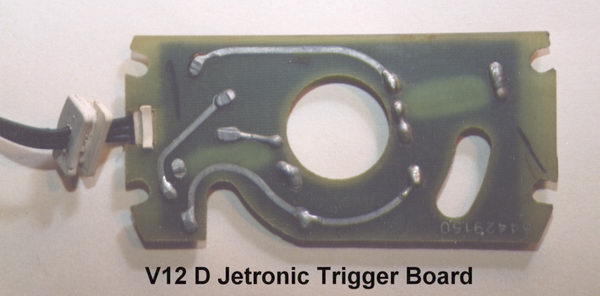I have a spare distributor, but not prepared to give it up. But there are often old distributors for sale on eBay and on the forums (try Benzworld too) . I think I paid about $60.00 for my spare.
A couple of other points:
- At least one owner on Peachparts, bought two of the much cheaper VW trigger point sets and used them to rebuild the MB points.
- Bosch now sell a
rebuild kit for the trigger points Bosch part number F 026 T03 035. As I understand it, it uses the existing baseplate and cables/socket. Pricey it seems - 400Euros or more.
- Late Jaguar D-Jets eliminated the trigger points and used what I think was a hall effect system (something like the Pertronix ignition point replacement) See below,
Only things that wear on the trigger points are the fibre rubbing blocks. You would think that someone could set a set of 4 for under $20.00.
Jaguar Info:
Quote:
Injector pulses are timed and initiated by trigger switches mounted diametrically opposite to each other within the distributor. Bosch had used a pair of miniature contact breakers (duplicated for the rare 8 cylinder / 4 injector group system mentioned earlier to provide the necessary 4 trigger pulses) in earlier applications but this was not easy to arrange within the Jaguar V12 distributor, quite apart from being seen as a retrograde step on an engine with electronically triggered ignition. By simply mounting a magnet in the "balance mass" of the rotor arm it was possible to operate magnetic reed switches encapsulated in a "trigger board" without any great difficulty although greater reliability was obtained subsequently by adopting "Hall Effect" sensors (magnetically switched transistors) instead. The early reed switch board had just three wires in a ribbon (one channel each side and ground in the centre) while the Hall Effect type had a fourth wire for connection to the switched ignition 12 volt supply.
As each trigger briefly closes a circuit to ground it initiates an injection cycle for the associated injector group starting with the primary pulse. The frequency of triggering provides a measurement of engine speed which influences the pulse circuits to provide the appropriate correction factor to the primary pulse. This function, known as the speed law, causes the injector pulse to increase gently until the speed of maximum torque is reached after which the pulse starts to shorten. This can be represented by a graph plotting pulse width against speed on which a line curves gradually upwards to a hump before finally tailing off. Component selection determines the upward and downward slopes and therefore also the peak of the curve. In this way the fuel input is matched to the volumetric efficiency of the engine although obviously without the precision (not always fully exploited) which modern programmed systems are capable of. 
|